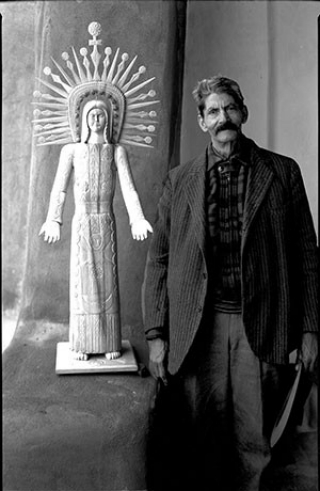Born 1868, died 1937, Córdova, New Mexico
José Dolores López trained as a farmer and carpenter in the town of Córdova, about halfway between Santa Fe and Taos, New Mexico. Working in a traditional Hispanic aesthetic, López created hand-carved, brightly painted furniture and domestic fixtures along with highly decorative silver filigree jewelry. His work was recognized by art advocates—such as those with the Spanish Colonial Arts Society in Santa Fe—and was part of a larger American interest in indigenous and Hispanic arts produced in the Southwest. Mabel Dodge Luhan and her Taos Art Colony were among those who sought out southwestern artifacts in an effort to broaden the acceptance of vernacular American art beyond northeastern folk traditions. Responding to this burgeoning market, López ceased painting his religious sculptures (bultos) and began decorating them with ornate, incised patterning and detailed chip carving. Between 1933 and 1934 López joined the Public Works of Art Project and applied his newfound method to elaborate narratives, religious scenes, and devotional carvings. His sculptures were widely shown, including in an exhibition at the Corcoran Gallery of Art, Washington, DC, in 1934.
In Adam and Eve and the Serpent, López portrayed the Edenic story of original sin in two separate parts. Eve unifies the divided scene, with one arm outstretched toward the proverbial “Tree of Life” at the left and the other offering an apple to Adam, who stands behind her. Meanwhile, the body of a serpent, carved in low relief, coils around the trunk, as the three-dimensional head emerges among the branches. The foliage is meticulously realized throughout, with each leaf individually sculpted to define the veining. Through his innovative style, based in intricate craftwork, López engendered the artisanal Córdovan style of woodcarving. Both his late son, George López, and his granddaughter, Sabinita López Ortiz, carried on his artistic legacy as santeros (makers of sacred paintings and sculptures).
Nicholas Miller
Briggs, Charles L. The Wood Carvers of Córdova, New Mexico: Social Dimensions of an Artistic “Revival.” Albuquerque: University of New Mexico Press, 1989.
Nunn, Tey Marianna. Sin Nombre: Hispana and Hispano Artists of the New Deal Era. Albuquerque: University of New Mexico Press, 2001.
